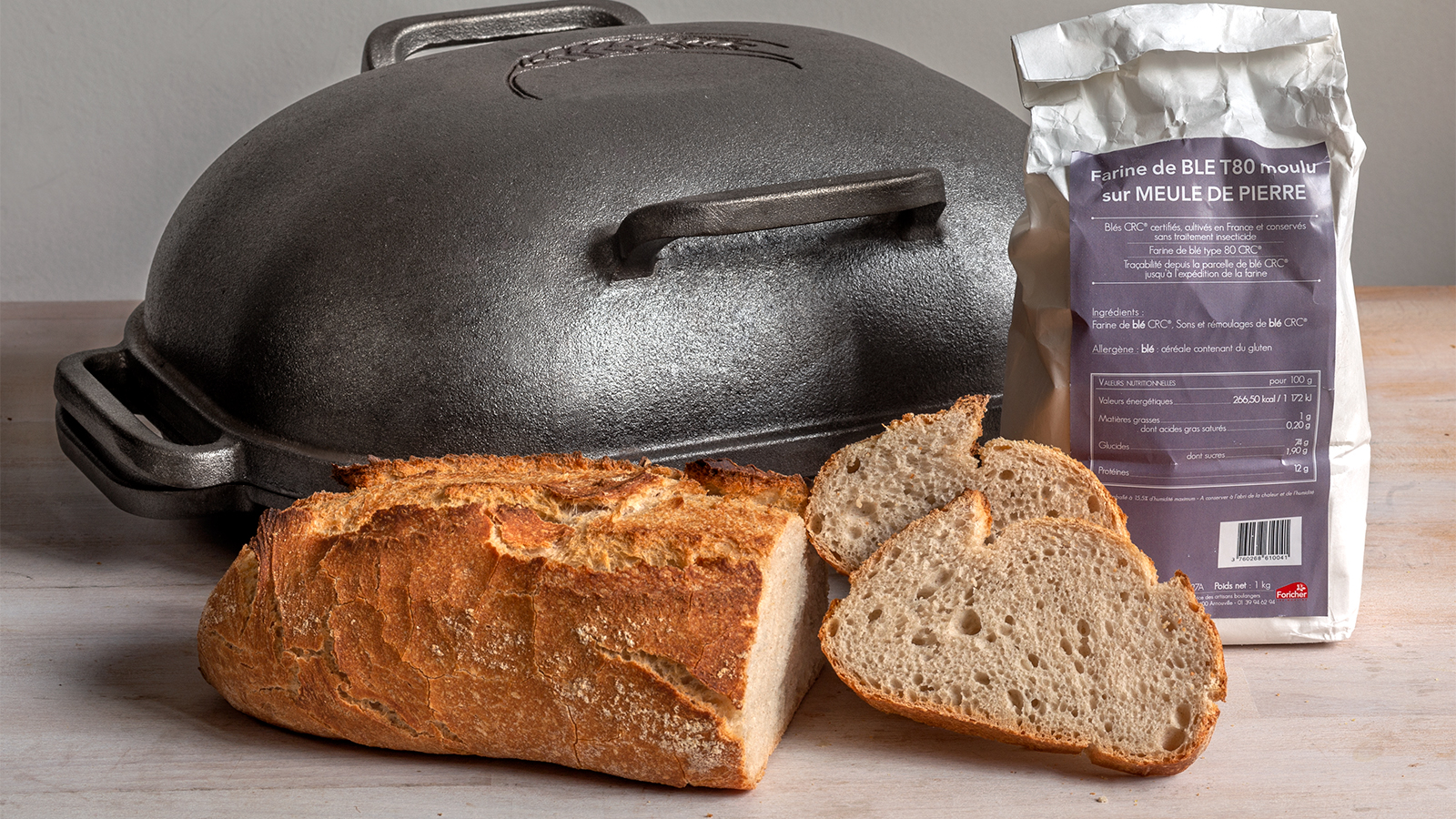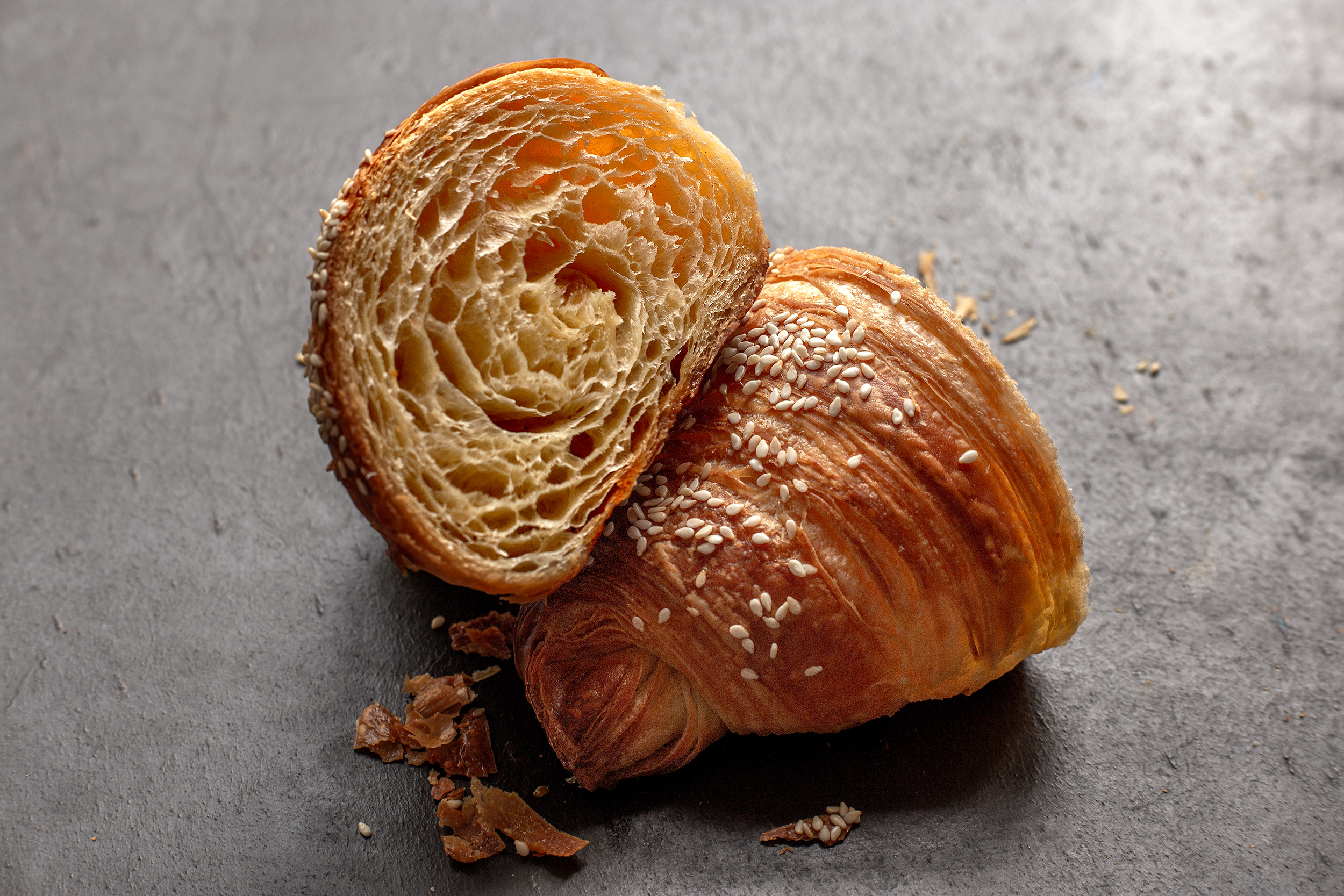Confused about these numbers in the names of many French flours: from T45 up to T150? Then find out here just what the French T-system for grading flour is all about.
Choose the flour that’s right for what you want to bake…ideal for baguettes:
Matthews French T55 Belle Blanc
A great general-purpose baguette flour, with excellent elasticity and stretch with low stickiness. The wheat is grown in France and milled by one of France’s oldest milling families. Protein: 8-10%
Foricher Tradition Française T65 flour
A full-bodied baguette flour. Contains more of the bran for a darker crumb colour, increased flavour but a slightly more delicate dough that needs careful handling. Can be mixed with a stronger flour for more resilience. Protein: 11%
Foricher Farine Biologique T65
An organic French baguette flour, milled allowing for more bran in the flour, producing a dough that needs gentle handling but with a rich flavour and colour. Protein: under 10%
Viron T55 Classic flour, 25kg only
The famous French flour used to make Rétrodor Tradition Française baguettes. Contains a small % of ground fava bean (broad bean) flour, a traditional way of giving more stretch and resilience to the dough. Protein: 10-12%
Viron French Tradition Française T55 flour, 25kg only
Excellent for that artisan-style of rugged, aerated baguettes with a rich cream crumb colour. Protein: 10.5-11%
So I’ve read that French flour contains ash, and the T-system tells you how much ash it contains. What kind of ash is it?
Let me stop you here. French flour does not contain ash, this is all untrue. It’s like some kind of whispering game has gotten out of control, and the science of grading flour in France has become twisted in translation.
The T-system in France (& Germany) grades flours according to what is left after it is incinerated in a laboratory testing process. The white part of the flour is mainly composed of starches and sugars, that disappear when the flour is heated to 900°C. What remains after the flour is burnt for 1 hour, the “ash” if you like, is made up of parts of the bran and anything other than those starches and sugars in the flour.
So it’s not that French flour contains ash. If you were to incinerate any flour you would get comparable results and leftover ash, it’s really not that ash in itself is special characteristic of French flour.
So if ash is the bran, why do I read the ash being described as the mineral content of the flour?
Again, because of a kind of misunderstanding. Wholemeal or bran-rich flours are made up of cellulose fibre, vitamins, trace elements and minerals. When the flour is incinerated for T-system flour testing, the minerals are part of the ash that remains. And so sometimes the ash remaining is described as the mineral content of the flour, because it is ...in part.
So how is the French flour burnt and measured? Something like a scene from Les Miserable?
Not quite. 5g flour is put inside a container (made of platinum or silica) and heated in a furnace to 900°C for a minimum of 80 minutes. Then the ash remaining is weighed to get a percentage compared to the original 5g raw flour. The numbers are rounded up to fit a category, and this is something to keep in mind (see below).
T45 > Less than 0.50% remaining ash per 5.00g flour
T55 = 0.50% to 0.60% remaining ash per 5.00g flour
T65 = 0.62% to 0.65% remaining ash per 5.00g flour
T80 = 0.75 to 0.90% remaining ash per 5.00g flour
T110 = 1.00% to 1.20% remaining ash per 5.00g flour
T150 < 1.40% or more remaining ash per 5.00g flour
So the lower the number the whiter the flour; the higher the number the closer to wholemeal it gets?
That’s pretty much it.
So was the T-system introduced to help millers and bakers choose flour?
Err, no, it was introduced to help the French taxman regulate the production of flour milled according to home much of the whole grain it contained. These days it is less helpful to bakers (and, to some extent, millers) as good bread, pastries, cakes can be made from many grades of flour, customers are much more diverse in what they want they traditional baked things to be like - wholewheat brioche, anyone - and the t-system tells you nothing about the protein quality and levels, or natural sugars and maltose, it contains.
The best flour chosen by the BakeryBits team… ideal for croissant, puff pastry, brioche:
Foricher Farine de Gruau T45
A strong flour with a very pale colour, producing a crumb that is exceptionally light and fine. One of France’s top viennoiserie flours, excellent for croissant, puff pastry, brioche. Protein: 12+%
Viron French Pastry and Croissant Flour T55 Gruau Flour, 25kg only
A very strong flour, excellent when high extensibility and resilience is needed in laminated dough, or when mixed with low-protein or darker high-extraction flours. Protein: 12+%
Viron "Corde Américaine" T55, 25kg only
A strong flour, Perfect for puff pastry, croissant, Danish pastry, and brioche. Milled with 30% high-protein wheat. Protein: above 11%
So the importance of the T-system for bakers is…?
Almost nothing, you have to go with the advice from the miller, written on the packet or website. Or a recommendation from us at BakeryBits, or other bakers. And take into account that your skills, combined with your familiarity in using a particular flour, and your flexibility on what sort of recipe, technique and oven temperature bests suits it, will determine what the result you get is like. T-numbers give you an idea or the flavour and colour to expect from a flour, but tell you nothing about the protein or gluten qualities of it. But the miller will guide you, via their descriptions used to sell the flour, on what their flours characteristics are, and what you can bake best with it.
So I’ve read that a T45 is perfect for pastry, and a T65 is great for bread. Is that true?
Not necessarily, especially today, but not a bad place to start. See, you can have a T45 flour that is tested and found to result in 0.49% remaining ash per 5.00g flour. But you could also have a T55 flour that found to result in 0.50% remaining ash per 5.00g flour. That’s a miniscule difference of 0.01%, so they’re in T-number terms very similar flour.
The T-number system was started in France in 1963, and back then the colour of the crust and crumb, and its delicacy, were considered very important: “finer” baking had a lighter whiter crumb; while baking and breads for the working persons table, thought back then to be of a “lesser quality”, could have a darker browner crumb. So because a T45 flour would produce a very pale crumb, it meant that the colour of other ingredients – like butter and eggs – was more evident, making T45 a suitable flour for enriched baking.
Taste and style play a part too. For example, while 30 years ago when I started baking T45-type flour were commonly used for viennoiserie (think croissant, puff pastry, brioche), today T55-type flours are commonly used for making them as this gives more flavour.
SACRÉ BLEU, WHAT THE… are you telling me that a T45 could be high protein/gluten flour, and T55 could be a low protein/gluten flour!?!
Oui, mon chéri.
So is there a way to tell the strength or gluten-quality of the flour by the T-number, or other ways?
Not by the T-number, but yes there are sometimes other indicators beyond the description given by the miller. For example, you’ll see the word “Gruau” sometimes used in combination with T-numbers. Like Farine de Blé T45 Gruau. The word gruau in this context means “strong”, so when you see it, it means that – in the case of a T45 Gruau – it is a very pale fine wheat flour with very little bran giving you an extensible resilient dough with good gluten characteristics.


















